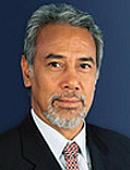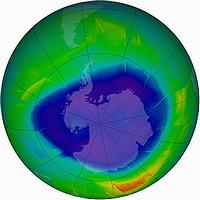 東帝汶16日批准管制臭氧層破壞物質的《蒙特婁議定書》,為世界上第196個、也是最後一個簽署該公約的聯合國會員國。此舉並為國際環保公約寫下新的里程碑,讓蒙特婁議定書成為第一個獲得全球一致批准的國際環保協議。
東帝汶16日批准管制臭氧層破壞物質的《蒙特婁議定書》,為世界上第196個、也是最後一個簽署該公約的聯合國會員國。此舉並為國際環保公約寫下新的里程碑,讓蒙特婁議定書成為第一個獲得全球一致批准的國際環保協議。
東帝汶是世界上成立最晚的國家,該國總理古斯芒(Xanana Gusmao)16日批准該議定書時表示:「東帝汶很高興能加入世界各國的陣營,一起遏止臭氧層破壞並協助其修復。」
此項國際環保進展別具意義。因9月16日同時也是聯合國明訂的「國際臭氧層保護日」, 以彰顯22年前該議定書首度開放世界各國簽署之日。
1989年1月1日,「保護臭氧層維也納公約」(Vienna Convention for the Protection of the Ozone Layer)生效,其後幾經修訂而成現行的《蒙特婁議定書》。該議定書受到國際上廣泛的採納與執行,被譽為國際合作的特殊典範。
聯合國環境規劃署執行長史坦納表示,「東帝汶的批准動作,讓臭氧層保護日別具意義,並顯示只要在環境議題上全世界全力合作,會有多重的延伸效益。」
蒙特婁議定書的建立,是為了淘汰使用破壞平流層的污染物質,以使地球擁能夠屏障來自太陽的破壞性紫外線。預計在未來數個月內,會有將近100種涉及破壞臭氧的化學物質列入淘汰名單。
史坦納表示:「沒有蒙特婁議定書與維也納公約,大氣中的臭氧層破壞物質含量,恐怕會在2050年增為10倍之多,這將會讓2000多萬人染上皮膚癌,1300多萬人罹患白內障,更別提人類免疫系統、野生動植物與農業上的損害。」
 2009年南極上空的臭氧層破洞已然成型,科學家觀察到,其大小可能與過去十年的規模差不多。美國太空總署戈德飛行中心(Goddard Space Flight Center)位於馬里蘭州綠帶市,該中心研究員紐曼(Paul Newman)表示,「今年我們已觀察到臭氧層破洞正在成型,目前為止大小還算一般。但我們不確定再過四周,今年的破洞大小最終會如何。」
2009年南極上空的臭氧層破洞已然成型,科學家觀察到,其大小可能與過去十年的規模差不多。美國太空總署戈德飛行中心(Goddard Space Flight Center)位於馬里蘭州綠帶市,該中心研究員紐曼(Paul Newman)表示,「今年我們已觀察到臭氧層破洞正在成型,目前為止大小還算一般。但我們不確定再過四周,今年的破洞大小最終會如何。」
根據最近的觀察與數像研究報告顯示,從2001年以來,每年臭氧層破洞大小已日趨穩定,而臭氧層破壞物質的含量也降低了4%。但科學家表示,氯化物與溴化物在大氣中存在的時間極長,臭氧層的復原可能至少要到2020年才觀察得出來。
臭氧層破壞物質包括氟氯碳化物(CFC)、氟氯烴(HCFC)、海龍(halon)、溴化甲烷、四氯化碳及三氯乙烷。這些氣體常用於冷媒、阻燃劑、溶劑與發泡劑等,而溴化甲烷則是用作殺蟲劑與燻蒸劑。
這些物質在低空大氣層通常非常穩定,只有在強烈紫外線照射下才會分解。一旦分解,將釋放出氯、溴分子,進一步破壞臭氧層。
全球性監測資料證實,大氣中關鍵的臭氧層破壞物質正在逐漸減少。科學家相信這是《蒙特婁議定書》逐步淘汰使用此類物質的政策使然,若持續下去,在2050至2075年期間,臭氧層將可回覆到1980年代以前的水準。
由於臭氧層破壞物質也是潛在的溫室氣體,蒙特婁議定書的執行也有助於對抗全球暖化。
史坦納表示,「據粗略估計,淘汰臭氧層破壞物質的作法,大約讓全球暖化效應從1990年以來延緩了7至12年。這意味著,每一分花在臭氧層保護上得投資,都會在其他環保議題上獲得回報。」
聯合國臭氧秘書處(Ozone Secretariat)執秘葛薩拉茲(Marco Gonzalez)指出,當前保護臭氧層的重點目標已非氟氯碳化物(CFC)等早期淘汰使用的物質,而是其危險的替代物質如氟氯烴(HCFC)與氫氟碳化合物(HFC)。而由於HCFC的氣候變遷效應,各國政府已於2007年同意加速淘汰與凍結該物質的使用。
The Montreal Protocol on Substances That Deplete the Ozone Layer today became the first environmental treaty to attract universal participation by all the 196 governments of the world.
Today, Xanana Gusmao, Prime Minister of the world's youngest nation, East Timor, or Timor-Leste, made environmental history with his announcement that his government has ratified the treaty, bringing the number of participating states to 196.
"Timor-Leste is very pleased to be joining the rest of the world in the fight against the depletion of the ozone layer and the effort towards its recovery," Gusmao said.
The announcement comes on the United Nations International Day for the Preservation of the Ozone Layer, which marks the day 22 years ago that the protocol was opened for signature.
The protocol to the Vienna Convention for the Protection of the Ozone Layer entered into force on January 1, 1989 and has been revised seven times. Due to its widespread adoption and implementation, the Montreal Protocol has been hailed as an example of exceptional international cooperation.
"The ratification by Timor-Leste makes this special day even more special and a signal that when the world fully and wholly unites around an environmental challenge there can be multiple and transformative effects, said Achim Steiner, executive director of the UN Environment Programme.
Established to phase out pollutants damaging the layer of stratospheric ozone that shields the planet from the Sun's damaging ultraviolet rays, the treaty will within a few months place close to 100 chemicals linked to ozone damage on the list to be retired.
"Without the Montreal Protocol and its Vienna Convention, atmospheric levels of ozone-depleting substances would have increased tenfold by 2050 which in turn could have led to up to 20 million more cases of skin cancer and 130 million more cases of eye cataracts, not to speak of damage to human immune systems, wildlife and agriculture," Steiner said.
The annual ozone hole has started developing over the South Pole, and scientists say it will be comparable to ozone depletions over the past decade.
"We have observed the ozone hole again in 2009, and it appears to be pretty average so far," said ozone researcher Paul Newman of NASA's Goddard Space Flight Center in Greenbelt, Maryland. "However, we won't know for another four weeks how this year's ozone hole will fully develop."
Recent observations and several studies have shown that the size of the annual ozone hole has stabilized and the level of ozone-depleting substances has decreased by four percent since 2001. But since chlorine and bromine compounds have long lifetimes in the atmosphere, scientists say a recovery of atmospheric ozone is not likely to be noticeable until at least 2020.
Ozone depleting substances include chlorofluorocarbons, or CFCs; hydrochlorofluorocarbons, or HCFCs; halons; methyl bromide; carbon tetrachloride; and methyl chloroform.
These gases are used as refrigerants, flame retardants, solvents, foam blowing agents, and in the case of methyl bromide, as a pesticide and fumigant.
These substances are generally very stable in the lower atmospheric levels and only degrade under intense ultraviolet light in the stratosphere. When they break down, they release chlorine or bromine atoms, which then deplete the ozone layer.
Global observations have verified that atmospheric levels of key ozone-depleting substances are diminishing. Scientists believe that due to their phase-out under the Montreal Protocol, the ozone layer should return to pre-1980 levels in the period between 2050 and 2075.
Because most ozone depleting substances are also potent global warming gases, the actions taken under the Montreal Protocol have contributed to the global effort to address climate change.
"By some estimates," said Steiner, "the phase-out of ozone-depleting substances has since 1990 contributed a delay in global warming of some seven to 12 years, underlining that a dollar spent on ozone has paid handsomely across other environmental challenges."
Marco Gonzalez, executive secretary of the Ozone Secretariat, said the focus is now switching from the gases such as CFCs that were phased out earlier to the dangers of their replacements, the HCFCs and HFCs.
In 2007, governments agreed to accelerate the freeze and phase-out of HCFCs because of their climate change impacts.



